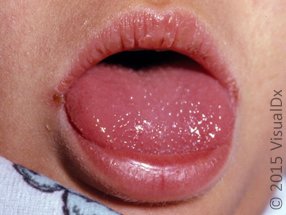Published on
Urgent message: Although measles was declared eliminated in the United States in 2000, outbreaks continue to occur, with unvaccinated travelers most often being the carriers and transmitting the disease to clusters of unvaccinated individual residents.
Overview and Current Outbreak
According to the World Health Organization, 145,700 people around the world died of measles in 2013, which equates to 400 deaths per day or 16 deaths per hour. Measles remains one of the leading causes of death in young children worldwide.
In 2011, the Centers for Disease Control and Prevention received reports of 200 measles cases in the United States. In 2013, 189 cases were reported, and in 2014, a record 644 cases from 27 states were reported. Between January 1 and February 6, 2015, more than 120 cases of measles in more than 12 states have been reported. Most have been linked to an outbreak that began in December 2014 at Disneyland in California.
About Measles
Measles (rubeola) is caused by a single-stranded RNA virus of the Paramyxoviridae family. The disease is worldwide in distribution, with sustained outbreaks being reported in many countries. Cases are more common in developing countries, because the majority of individuals in industrialized nations have been vaccinated. The infection primarily occurs in late winter and spring. The disease is seen more often in children than in adults. In an unvaccinated population, children younger than 5 years are at highest risk of infection and death, usually because of a respiratory or neurologic complication.
Measles is transmitted via respiratory droplets, and it is highly infectious. The incubation period after the measles virus enters the upper respiratory tract and nasal passages is about 10 days (range, 7–21 days), with the rash typically appearing about 14 days after a person is exposed. Infected individuals are considered contagious for the time period encompassing 4 days before rash appearance to 4 days afterward.
What to Look For
A prodrome characterized by coryza (nasal congestion), cough, fever (up to 40.5°C), and conjunctivitis lasts for 3 to 4 days, and rash onset follows. However, sometimes immunocompromised individuals do not develop a rash. The coryza, “barking” cough, and conjunctivitis will increase in severity until the rash reaches its peak.
Oral lesions called Koplik spots (Figure 1) may develop 2 to 3 days after symptoms begin and prior to the generalized rash eruption. Look for small white papules that may have a central bluish-white speck, usually opposite the second molars on the buccal mucosa. They may also be red. Bluish-gray or white spots can also be seen on the tonsils.
The measles rash consists of erythematous macules and papules beginning behind the ears and at the forehead, spreading down the neck to the upper extremities, trunk, and finally the lower extremities, a process called centrifugal spread. Confluent lesions can occur on the face. Figure 2 shows the measles rash in children, and Figure 3 shows the rash in adults.
In atypical measles, which occurs in those who received killed-virus vaccine or in those in whom immunization failed, the rash will spread from the extremities inward (Figure 4). Petechiae, vesicles, or papules can occur. Cough and conjunctivitis are not as prominent as in typical rubeola.
Differential Diagnosis
Before the eruption of the rash, it is easy to confuse rubeola with common upper respiratory infections. Other viral exanthems with a similar presentation include
- Infectious mononucleosis (Figure 5)
- Erythema infectiosum (Figure 6)
- Roseola (Figure 7)
- Rubella (Figure 8)
- Rocky Mountain spotted fever (Figure 9)
- Enteroviral infection (Figure 10)
- Kawasaki disease (Figure 11)
Several medication-associated rashes also have presentations similar that of measles:
- Exanthematous drug eruption (Figure 12)
- Drug hypersensitivity syndrome or drug reaction with eosinophilia and systemic symptoms (Figure 13)
Treatment and Therapy
Treatment is supportive, focusing on relieving common symptoms and providing nutritional support, including vitamin A supplementation. Supplementation is recommended for children in areas where the case fatality rate is more than 1%, in areas where residents are known to have vitamin A deficiency, and in cases of severe, complicated measles.
Rest, antipyretics, and antitussives are appropriate adjunctive treatment measures. Pay close attention to fluid balance, and keep the patient well hydrated. Patients who develop complications, such as pneumonia, encephalitis, or severe diarrhea, may require hospitalization; maintain a high level of suspicion for these conditions. Complications are most common in children younger than 5 years and adults older than 20 years. Overall complication rates are as follows:
- Death, 0.2%
- Diarrhea, 8%
- Encephalitis, 0.1%
- Pneumonia, 5%
- Hospitalization, up to 19%
Reporting Requirements
Reporting is regulated by state health laws and regulations. All U.S. states require that measles cases be reported.
Bibliography
Centers for Disease Control and Prevention. Frequently asked questions about measles in the U.S. Atlanta, GA: Centers for Disease Control and Prevention [cited February 10, 2015; last updated February 3, 2015] . Available from: http://www.cdc.gov/measles/about/faqs.html#measles-elimination
Centers for Disease Control and Prevention. Immunization schedules. Atlanta, GA: Centers for Disease Control and Prevention [cited February 10, 2015; last updated January 26, 2015]. Available from: http://www.cdc.gov/vaccines/schedules/
Centers for Disease Control and Prevention. Measles cases and outbreaks. Atlanta, GA: Centers for Disease Control and Prevention [cited February 10, 2015; last updated February 17, 2015] . Available from: http://www.cdc.gov/measles/cases-outbreaks.html
McLean HQ, Fiebelkorn AP, Temte JL, et al; Centers for Disease Control and Prevention. Prevention of measles, rubella, congenital rubella syndrome, and mumps, 2013: summary recommendations of the Advisory Committee on Immunization Practices (ACIP). MMWR Recomm Rep. 2013;62(RR-04):1–34. Available from: http://www.cdc.gov/mmwr/pdf/rr/rr6204.pdf
Orenstein WA, Perry RT, Halsey NA. The clinical significance of measles: a review. J Infect Dis. 2004;189(suppl): S4–S16. Available from: http://jid.oxfordjournals.org/content/189/Supplement_1/S4.long
Acknowledgment: Images and report courtesy of VisualDx (www.visualdx.com/JUCM). Also see the webinar “Spotting Measles” from VisualDx at http://youtu.be/1DaXWIA1WZA.
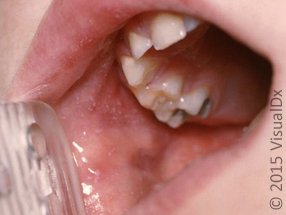 |
| Figure 1. Koplik spots. |
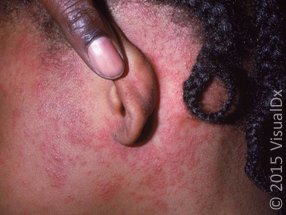 |
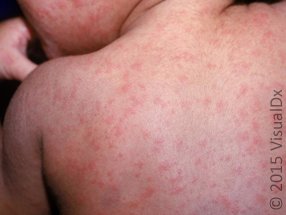 |
| A | B |
| Figure 2. Measles rash in children: (A) on the face and head and (B) on the back. | |
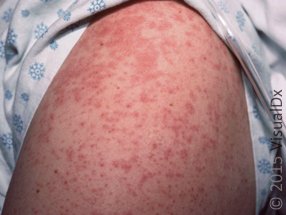 |
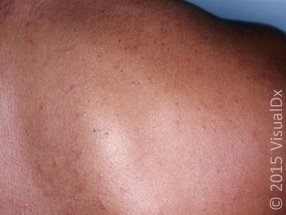 |
| A | B |
| Figure 3. Measles rash in adults: (A) on the extremities and (B) on the back. | |
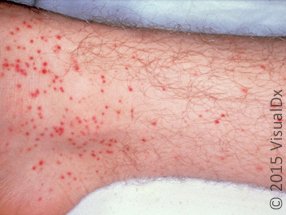 |
| Figure 4. Rash in atypical measles. |
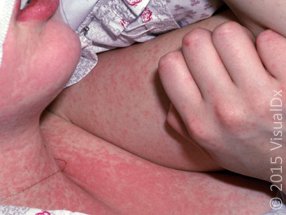 |
|
| Figure 5. Infectious mononucleosis. Pharyngitis and adenopathy are more significant in this disease than in measles. |
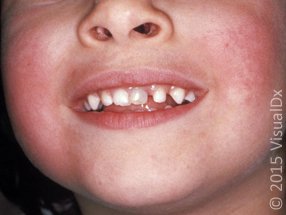 |
|
| Figure 6. In erythema infectiosum, the rash begins as bilateral erythema of the cheeks (“slapped cheek” appearance). |
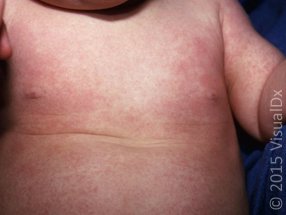 |
|
| Figure 7. In roseola, the rash typically begins on the trunk and may spread to the neck and upper and lower extremities. |
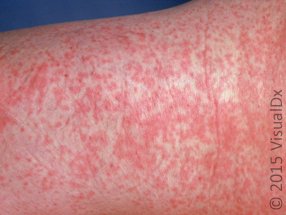 |
|
| Figure 8. Rubella. Before the onset of rash, pain on lateral or upward eye movement is common. |
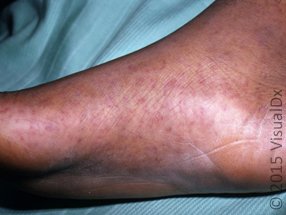 |
|
| Figure 9. Rocky Mountain spotted fever, usually transmitted by travelers from an area where the disease endemic or contracted by residents of such areas. |
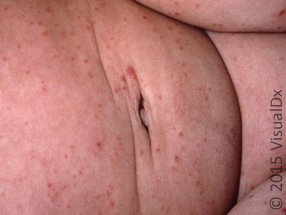 |
|
| Figure 10. Patients with an enteroviral infection may have accompanying nonspecific symptoms. |
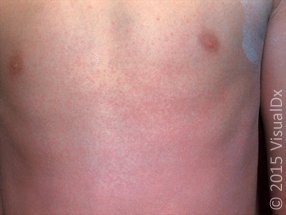 |
|
| Figure 12. Drug-induced exanthema. Onset is usually within 7 to 14 days of initiation of a course of oral medication. |
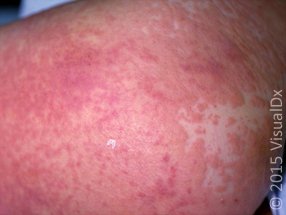 |
|
| Figure 13. The onset of drug hypersensitivity syndrome or drug reaction with eosinophilia and systemic symptoms is usually between 1 and 8 weeks after starting a drug for the first time. |

